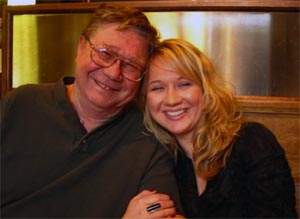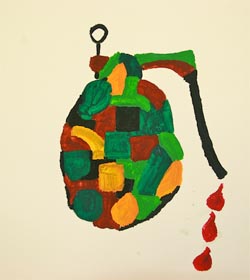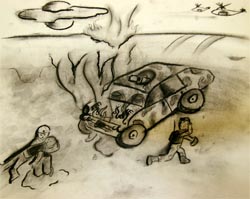 Download PDF of this full issue: v43n1.pdf (21.1 MB)
Download PDF of this full issue: v43n1.pdf (21.1 MB)From Vietnam Veterans Against the War, http://www.vvaw.org/veteran/article/?id=2235
 Download PDF of this full issue: v43n1.pdf (21.1 MB) Download PDF of this full issue: v43n1.pdf (21.1 MB) |
He stands shaking at the podium. As he relates his gut-wrenching, heartbreaking story, his voice breaks and tears flood down his weathered face. Over the course of 27 years I've heard a million of his stories, he only tears up when he tells this one. He quickly wraps it up and wishes everyone a safe and happy Memorial Day while retreating from the podium, moving as if composed of cast-iron. The air is thick with a heavy sense of loss. His fellow veterans pat him gently on the back while commenting to one another on the nice turn out this year and hastily begin cleaning up.

|
| Trina and her father. |
My dad is a Vietnam veteran, and quite a storyteller. Usually the stories illustrate in vivid detail some crazy spot he and his buddies ended up in while fishing, hunting or pulling a prank. But every once in awhile stories of war come seemingly out of nowhere, and it sometimes feels as if he's there again. My passion for working with veterans stems from my observations and experiences related to my father's life-long struggle after serving in Vietnam 45 years ago.
It's impossible for me to imagine living through some of the stories my father has told, and yet, as he points out, he is only one of millions of veterans to carry such a burdensome story after returning from war. He believes his ability to talk about it, however, is rare, and sharing his story with others has been instrumental in helping him cope. In fact, research has confirmed that often times those that have experienced trauma have a difficult time verbally expressing their story. Paradoxically, giving a traumatic experience a narrative is a critical part of healing because it promotes acceptance and ultimately appropriate integration of the trauma into one's life. Art therapy fits uniquely into this paradox by supporting individuals' ability to access personal traumas through art creation and verbalization of what is being expressed through their work, to develop their personal trauma narrative.
In a podcasted interview with the National Endowment for the Arts, art therapist Melissa Walker discussed her 4-week art therapy treatment program for returning service members. Walker's art therapy program is part of the standard of care at the National Intrepid Center of Excellence, or NICoE, a facility that treats service members that have not responded to other treatments. Walker (2012) cited neuroimaging research performed at the NICoE indicating that, "The Broca's area of the brain, which is the speech area of the brain, shuts down when individuals try to recount a trauma. However, the part of the brain that encodes sensory experiences of trauma — sight, sound, smell, feel — that's the part that lights up, and it's the same part of the brain that you utilize when you're creating art" (http://www.nea.gov/podweb/podCMS/podlist.php). Walker went on to say that the NICoE is continuing this research and believes that the art therapy process is reintegrating the brain.

|
In a BBC television series special, "Art for Heroes: A Culture Show Special," art therapy's role in the rehabilitation of ex-service members is examined through interviews with neurologist Dr. Lukasz Konopka, and veterans participating in art therapy at Combat Stress, a treatment facility in England for combat-related PTSD. Dr. Konopka researched PTSD at Hines VA Hospital and has a particular interest in understanding how and why art expression is effective in therapy with this population. Konopka's research findings are similar to those found by the team at the NICoE. While describing art-making's visible neurological effects on the brain, he called art therapy, "essential because it taps into the very primitive networks of the brain." Konopka went on to explain that through art therapy, new neural pathways may be developed, which in turn allows the person to live a different life.
The documentary concluded with a show at a local gallery of the veterans' artwork. A reception was held with the aim of providing a positive experience out of what had likely been a painful one. When asked what they thought about art therapy's effectiveness, one veteran identified it as his "primary therapy" and described it as the catalyst that opened him up. At its essence, therapy is a process of changing awareness and behavior. Creativity and therapy are interconnected as processes of transformation, metamorphosis and change. You can hear this in another vet's explanation of his work. This vet identified himself as "a veteran turned artist" and in describing his process of creating a work of art stated, "I start with some kind of traumatic disruption and then some kind of rebuilding. That rebuilding is also a creation which has enabled me to move on."
Interestingly, in England, the roots of art therapy are often traced to Adrian Hill, a war artist on the western front during World War I. While Hill recovered from tuberculosis in a Hospital in 1938, he used art to aid his own recovery. He was later invited to return to the hospital to help returning war wounded soldiers by teaching them art. Art therapy continues to be a holistic avenue of treatment for returning soldiers. We are seeing some exciting collaboration between neurologists and art therapists at the Veterans Administration, where researchers have embraced the task of expanding the research base of how art therapy works neurologically, and why it is an effective tool for post-traumatic stress disorder.
Trina is wrapping up a Master of Science in Art Therapy and Counseling this Spring. She had the privilege of doing two rounds of practica at a residential treatment program for veterans where art therapy is part of the standard of care. She would love to hear thoughts, questions or concerns on the topic of art therapy and/or transitioning to civilian life from members of the veteran community and can be contacted via email at trinairish@gmail.com.

|